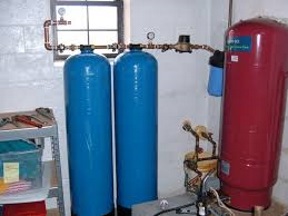Granular Activated Carbon (GAC) Filter System For Private Wells

What is a GAC Filter System?
A GAC filter system is used to remove semi-volatile and volatile organic compounds (such as those found in gasoline, heating oil, and chlorinated solvents), as well as some pesticides from polluted drinking water.
A GAC filter system used in single family homes and small businesses typically consists of two (2) canisters (primary and backup) installed in series. Each canister contains a minimum of one (1) cubic foot of granular activated carbon. A sediment filter, flow restrictor, flow meter, and sampling taps are typically included with the installation. An iron/manganese removal system may also be installed prior to the carbon filters if the concentrations of iron or manganese exceed recommended levels.
How does a GAC Filter System Work?
As polluted water passes through the carbon canisters, the activated carbon removes the pollutants from the drinking water as it enters the building from the well.
Why do GAC Filter Systems Need to be Monitored?
The ability of the activated carbon to remove organic compounds declines with use. Monitoring of the GAC filter system is necessary to determine when the activated carbon is allowing small concentrations of pollutants to pass through. This condition is called "breakthrough". If breakthrough occurs at the primary (first) filter, pollutants will then be removed by the backup (second) carbon filter. Monitoring is typically performed by analyzing one sample of untreated water, one sample collected immediately after the primary filter, and one sample collected after the secondary carbon filter.
What Kind of Maintenance is Required for a GAC Filter System?
The detection of pollutants in samples collected immediately after the primary carbon filter is an indication that maintenance is needed. Maintenance is conducted by removing the primary carbon filter, moving the backup carbon filter into the primary position, and installing a new carbon filter in the backup position. A new canister in the backup position ensures that the water being consumed is free of pollutants.
Replacement of the Sediment Filter
The sediment filter is designed to remove sediment from the water before it enters the carbon canisters. It will become clogged with use and will need to be changed in response to a reduction in water pressure. The frequency for changing the sediment filter will vary depending on the amount of sediment suspended in the well water.
For further information contact:
Department of Energy & Environmental Protection
Bureau of Water Protection and Land Reuse
Remediation Division
79 Elm Street
Hartford, CT 06106-5127
(860) 424-3705
Content Last Updated December 1, 2016

